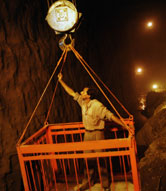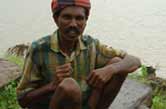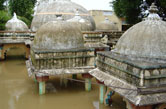By Diane Raines Ward
September 14, 2003
Water in India is a matter of extremes, veering between drought and floods, life and death. There is no other place on the planet with such wide vacillations between wet and dry. Water weighs so heavily on the Indian mind that the Hindu faithful see the country’s rivers as sacred. Yet, at the same time, mastery of these holy rivers has been vital to India’s existence. It is a campaign that has been waged for millennia — with mixed results.
The sub-continent is littered with evidence of the efforts. In central India, the 11th century Veeranam Dam once stretched for a full 10 miles. Two carved-rock slab dams from the same era created a 250 square mile lake in the central Indian state of Madhya Pradesh. Near Bhopal, the Mudduk Maur Dam was the highest earthfill embankment dam on earth for three centuries after its construction in 1500. Outside Hyderabad, Meer Allum, built over 200 years ago, was the first true multiple-arch buttress dam in history. Ancient waterworks are also still in use. In the desert states of Gujarat and Rajasthan, thousand-year-old, rock-carved step wells descend deep into the earth in tiers of ornate galleries to tap the water table.
Under the British Raj, dam building escalated. British engineers constructed some of the most advanced dams and canals in the world on Indian ground and by the time the Union Jack was lowered in New Delhi in 1947, they had put down 75,000 miles of irrigation canals to water the subcontinent’s most valuable farmland.
After Independence, Prime Minister Jawaharlal Nehru, deeply determined that India should become self-sufficient in food production and economically self-reliant, advanced the campaign still further. A series of Soviet-style Five Year Plans resulted in multi-purpose river control works that included the four-dam Damodar Valley Project in West Bengal and Jharkhand, inspired by America’s Tennessee Valley Authority, and, in the eastern Indian state of Orissa, the Hirakud Project, designed to irrigate over 1.5 million acres of crop land. Most promising of all was the Bhakra Dam, stretched across a 1,700-foot canyon on the Sutlej River to prevent floods and carry water and electricity to the fertile Punjab. At its dedication in 1963, Nehru famously called Bhakra, “the temple of a free India, at which I worship.”
That veneration continues. India remains one of the most active dam-building countries on earth. After Bhakra, a solid and largely successful dam, enormous dams became the order of the day. But, often, projects were launched without adequate planning or finance. A 1995 Indian Environment Ministry report revealed that 87 percent of India’s river-valley projects did not meet required safeguards. Recent reports show that larger dam reservoirs are silting up at rates far higher than assumed when the projects were built, that the life span of major Indian dams is likely to be only two-thirds of their projected life, and that every dam built in India during the last 15 years has violated various environmental regulations — from siltation and soil erosion, to the neglect of health, seismological, forest, wildlife, human, and clean water issues.
Two especially controversial examples are: Tehri, an 855-foot-high dam, the world’s fourth largest, that sits on the edge of the Central Himalayan Gap, one of the earth’s most tremulous seismic fault lines; and the massive Sardar Sarovar, which has already displaced tens of thousands of people in a drive for improved irrigation, flood control, and water supplies in Madhya Pradesh, Gujarat, and Rajasthan. Dam critics say the real beneficiaries are wealthy and powerful sugar refiners, who have been granted licenses to build 10 factories at the head of the main canal.
Yet, India, desperate for water, continues to build. The International Food Policy Research Institute recently predicted that rapid population growth will more than double South Asia’s food requirements in the next 25 years. More food means more water and, by 2025, India’s demand for water is expected to double as well. There are already chronic water shortages in Indian cities like Delhi, Bangalore, and Chennai, and groundwater levels are falling in many places around the country. Water conflicts have become persistent between Indian states and even between India and Bangladesh, sparking concerns that India’s water resources not be used carelessly.
Some of India’s most effective work with water is on a small scale and closely linked with her past. In a place where rain is concentrated in seasonal monsoons, storage remains vital. Every Indian town once possessed one or more water tanks that captured and held monsoon water or step wells that provided access to water kept deep underground where it would not evaporate. Scores of non-governmental organizations are helping people refurbish ruined tanks, to harvest rainwater, recharge wells, and restore degraded watersheds. This “silent revolution” has helped restore water sources to thousands of villages and towns across the country.
And not just in the countryside. New Delhi’s presidential palace now features a rainwater harvesting system and new government buildings are required to use similar technology.
Still, the enthusiasm for mega-water projects shows no signs of slacking. Current debate rages over what may be the world’s largest and most ambitious water project, a scheme meant to remake India’s hydrological map (and, in the process, correct India’s cycle of flood and drought) by taking water from 14 northern rivers and pumping it to 17 southern rivers in a $200 billion network of canals and reservoirs that would sprawl a thousand miles, and displace millions of people.
Whether India will continue to think big or opt for more localized solutions remains in question. No single solution will solve all of India’s water problems. Those dilemmas will require all of its attention and the knowledgeable involvement of its scientists, politicians, engineers, and ordinary citizens as the country faces the burgeoning population pressures of the 21st century.
Diane Raines Ward is a New York-based journalist whose work has appeared in NEWSWEEK, SMITHSONIAN Magazine, CONOISSEUR, and INTERNATIONAL WILDLIFE. She is the author of “Water Wars” (Riverhead Books, 2002), an overview of big dam projects around the globe and the politics of international water disputes. She first started covering dam controversies in the late 1980s with a story for SMITHSONIAN Magazine on Turkey’s Southeastern Anatolia Project.



